I really like good DIY write ups, and this one was especially well put together with great pics. If you've ever wanted to add CO2 to your grow, but can't afford a CO2 generator or burner, this might be for you! Thanks Jandre for letting me re-post this:
DIY CO2 Generator
by: jandre2k3
2 2Liter Bottles (Label removed and glue cleaned off)
Enough 1/4" Hose to run between the two bottles, and into the Flower Box and round the inside of your grow space.
1/4" Check Valve (I got mine from the aquarium section of my pet store near the air pumps)
1/4" Barb-type "T" coupling.
Thumb Tack
Caulk
15/64" drill bit
Drill
2 packets of Active Dry Yeast (4.5tsp)
4 TBSP sugar (1/4C)
1 Cup warm water (Brewer Bottle)
1L of cold water (Treatment Bottle)
Zip Ties
Preparation:
First measure out how much tubing you'll need INSIDE for your grow space. Measure around the inside walls of your grow space, or around the top of the bins your plants are in. (For this demonstration an Ebb&Flow system is used so the measurements were around the tops of the bins.) Just make sure there is enough tubing to go around the plants.
Measure out and cut that much 1/4" tubing.
Next, cut your length of tubing IN HALF making two equal lengths. This better ensures that the CO2 will reach the end of the tubing as the generator runs.
note: Pressure in the tubing will drop as it gets toward the end of the tubing. Running two lines from the main will increase the pressure in the shorter tubing a little bit to give a batter chance of running the escaping gas all the way to the end.
Next, measure out the space your 2 Liter pop bottles will be and cut enough tubing to run from the top of the first bottle through the cap, to the bottom inside the other bottle and cut a length so that your tubing makes a loop between the two.
Let's Get To Building!
The Reactor:
Drill 3 holes each 15/64":
1 hole in the center of cap for the first bottle and 2 holes in the cap of the second bottle.
Note: We are drilling slightly smaller that the diameter of the tubing to make a tight seal around the tubing so no gas leaks around the holes in the cap.
(You can optionally caulk the hoses into place.)
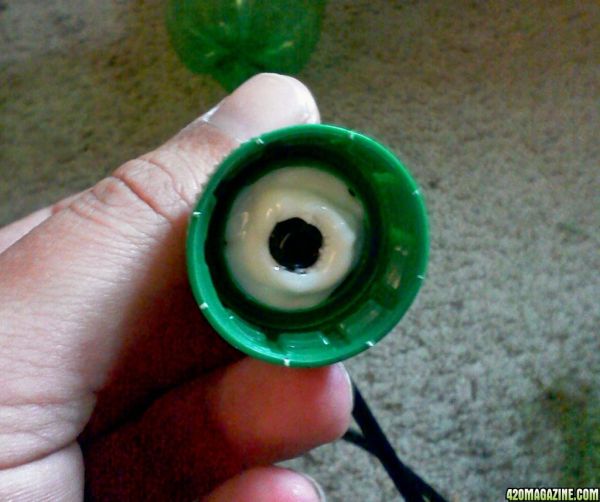
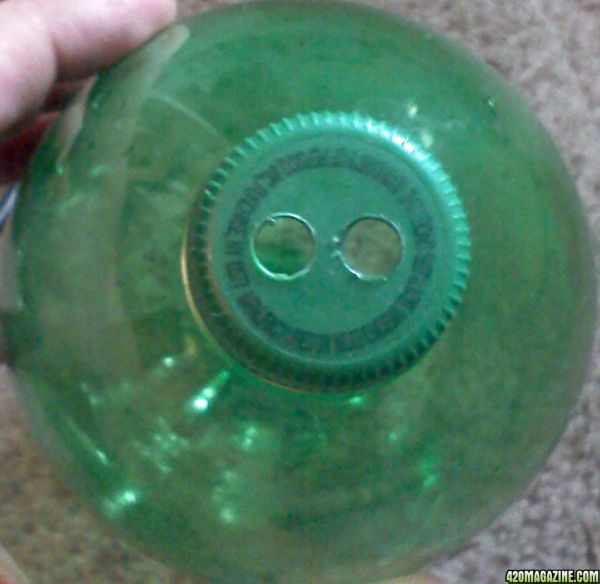
Next install the tubing for between the bottles into the first bottle and cut it at about 6".
Get your check valve,

notice that one side says "IN":

and the other side says, "OUT"

Place the "IN" side into the short tube you just cut off from the main length coming from your first bottle:
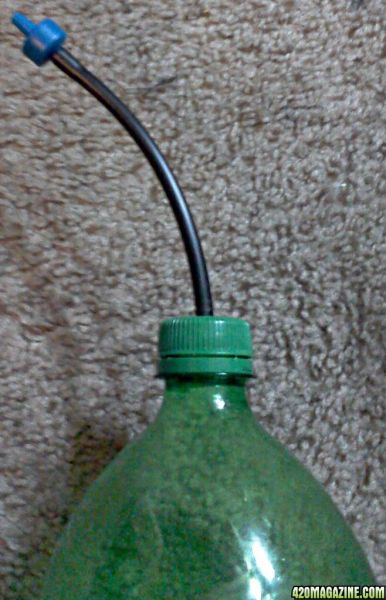
Then attach the rest of the tubing you just cut the the "OUT" side of the check valve.

This will ensure that no water flows back into your first bottle from the second.
Cut the other end of the tubing at an angle.

and insert it through one of the holes in the second bottle's cap all the way to the bottom.

The bias cut will make a larger opening to allow gas to escape easier, and also to keep the tube from being blocked if it is pushed all the way down and against the bottom of the bottle.
The Supply Hoses:
Now we need a way to get the CO2 to the plants.
Take those hoses we cut earlier from the measurements around the grow space and use the thumb tack to put holes into the tubing at 6" intervals. DO NOT press the tack all the way through the tubing. We're aiming to make the smallest hole possible so make sure you only push the tack through just enough to make it through to the inside. Half way into the tubing just through, and only half way up the taper of the point. Try not to go all the way up to the shaft of the pin itself. Just to the line in the picture below.
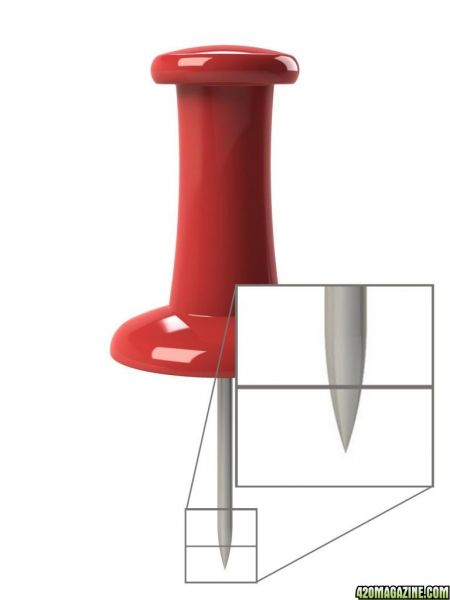
Remember: we're going for the tiniest of holes so we have good gas pressure all the way through the lines...

Now, fold the end of each tube and secure by wrapping several times with bare wire with no plastic (non-insulated type), and then with tape, to make sure it does not leak, or unfold.

Installation:
Now we're ready to put it all together!
First install the lines into your Grow Space, and secure with zip ties.
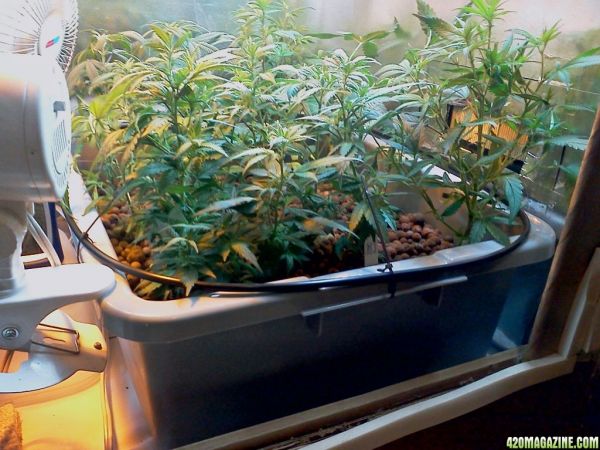

Next, attach the lines to the "T" coupling.

Now run line into your grow room and attach the end to the "T".

Measure down to the location for the second bottle, leaving a loop and cut off. Remove the cap from the second bottle and attach to the looped end of the supply line we just dropped out of the grow space.
Installation COMPLETE!!
Now we need to set up the reactor and get it brewing.
Set-Up!
First get together all your ingredients for both bottles
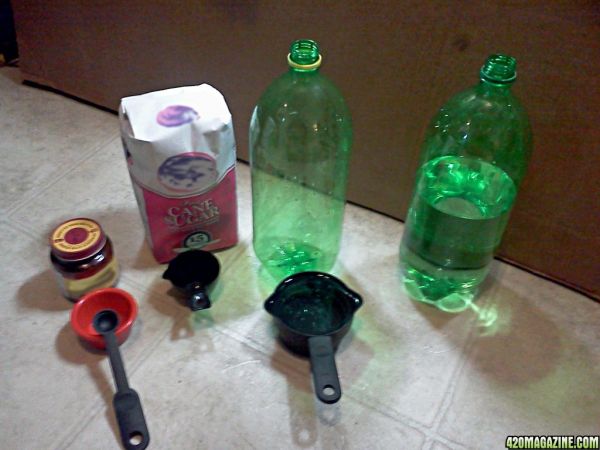
1 Liter of cold water goes into the second bottle, and the rest goes into the first bottle.
The idea behind the second Treatment Bottle is to remove the "beer smell" produced by the yeast.
To the Brewer Bottle, add the 4-1/2 tsp yeast:
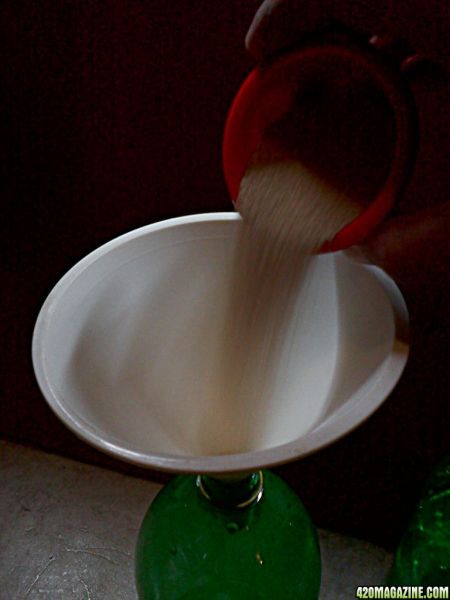
...and the 1/4 Cup of sugar:
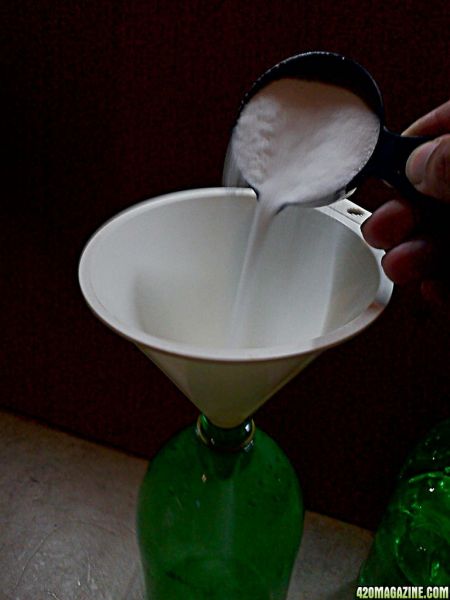
And now the warm (110*F) water.

agitate for 15 seconds to mix:
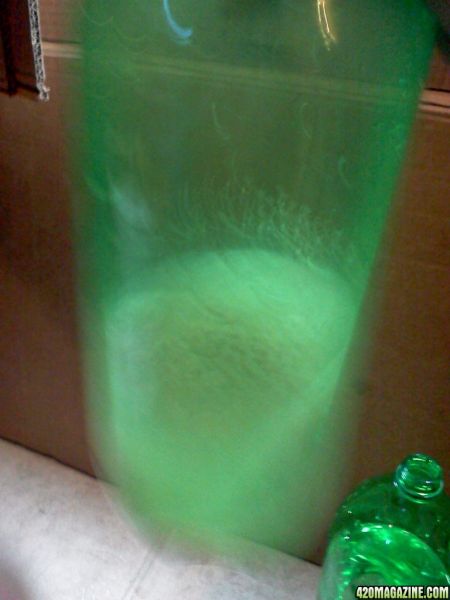
It should be a brown messy goop inside the Brewer Bottle now.

Now, cap your bottles. Single tube cap on the first bottle, and the double tube cap on the second bottle.
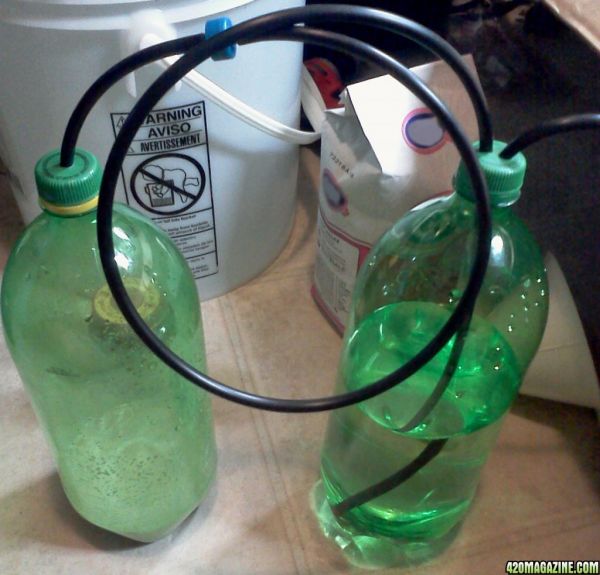
You're DONE!!
All you need do now is place the bottles is a nice dark place and let them work.

After a few minutes you will see bubbles coming through the clear water in the second bottle:

So now you know it's working and doing its thing.
Maintenance:
You will need to do a few things to keep your reactor in good working condition.
First 2 hours:
When you first set your reactor, the yeast will be overly active as they all come out of stasis and start to feed and multiply.
You will notice after about 15 to 30 minutes that there is a foam rising in your brewer bottle:

For the first hour or so, this will be VERY THICK and will over flow into your treatment bottle (NOT GOOD!) if something is not done.
Simply pick up your brewer bottle and tap in on the floor a few times until the foam settles out again:

KEEP AN EYE ON IT! This will need to be repeated 2 or 3 times in the first 1 to 1.5 hours... After that, there will still be foam, but it will be much less viscous and the bubbles will break inside and will not rise to the top.
Twice a Month:
Twice a month it is a good thing to add a little water, and another 1 TBSP of sugar. Yeast is a Non-photosynthetic algae. It requires 2 things to live, grow, and multiply. Sugar and water. Keep these two things in good supply and you should never have to dump and refill your Brewer Bottle and start over ever again. This is the same basic principle in a Sourdough starter. There is a bakery in San Francisco that has had the very same sourdough starter since 1909. It survived an earthquake and is still alive today by receiving a little care and maintenance. That same strain of yeast from 1909 is what gives the baker the signature San Francisco Sourdough flavor. Given the same care, and attention, your reactor should last you a lifetime.
Every Three Months:
Dump 1/2 to 3/4 of the liquid (NOT ALL) and replace with pure water and 1/4C sugar.
This keeps alcohol from getting too high and killing off the yeast.
----------------------
Thank you for reading, I wish you all the best. Enjoy your CO2 Generator! Keep'em Green, 420Mag readers!


